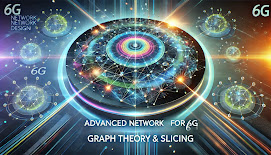Advanced Network Design for 6G: Graph Theory & Slicing
Advanced Network Design for 6G: Graph Theory & Slicing explores the integration of cutting-edge methodologies to meet the demands of 6G networks, emphasizing efficiency, scalability, and tailored performance. Here's a detailed breakdown:
1. Advanced Network Design for 6G
6G networks aim to deliver:
- Ultra-high data rates (terabits per second speeds).
- Ultra-low latency (in milliseconds or less).
- Massive device connectivity (billions of devices globally).
- Seamless integration of AI, IoT, and immersive technologies like AR/VR.
Designing such networks requires:
- Efficient Resource Utilization: Maximizing bandwidth and spectrum usage.
- Flexibility and Scalability: Adapting to diverse use cases like autonomous vehicles, industrial automation, and remote healthcare.
- Resilience: Ensuring robust performance under varying network conditions.
2. Graph Theory in 6G
Graph Theory provides a mathematical framework to model and solve problems in complex networks. Key aspects include:
Network Topology Representation
- Networks are represented as graphs where:
- Nodes are entities (e.g., devices, servers).
- Edges represent connections (e.g., communication links).
- Helps in visualizing and optimizing large-scale, interconnected systems.
Applications in 6G:
- Optimal Routing and Traffic Management:
- Identifying shortest paths and efficient routes for data transfer.
- Balancing network load to prevent congestion.
- Fault Tolerance:
- Modeling redundancy to ensure reliability during node or link failures.
- Dynamic Network Adaptation:
- Adapting to real-time changes in device density and connectivity requirements.
Graph Algorithms in Use:
- Dijkstra’s Algorithm: For shortest-path calculations.
- Minimum Spanning Tree (MST): To minimize resources in network connections.
- Clustering and Partitioning: For creating efficient subnetworks.
3. Network Slicing in 6G
Network slicing is the process of dividing a physical network into multiple virtual "slices," each optimized for specific use cases.
Key Features of Network Slicing:
- Customization:
- Each slice is tailored for specific performance metrics like bandwidth, latency, and reliability.
- E.g., low-latency slices for autonomous driving vs. high-throughput slices for video streaming.
- Dynamic Resource Allocation:
- Slices are dynamically created and scaled based on demand and network conditions.
- Isolation:
- Each slice operates independently, preventing interference between them.
Role in 6G:
- Massive IoT Support:
- Efficiently manage billions of connected devices with varying requirements.
- Enhanced User Experience:
- Guarantee service-level agreements (SLAs) for critical applications.
- Cost-Efficiency:
- Optimize infrastructure usage while reducing operational costs.
4. Integration of Graph Theory and Slicing
Combining these two methodologies enhances the design and performance of 6G networks:
- Slice Mapping Using Graphs:
- Represent slices as subgraphs within the larger network graph.
- Allocate resources efficiently by solving graph partitioning problems.
- Dynamic Reconfiguration:
- Use graph-based algorithms to adapt slices dynamically based on network conditions.
- Predictive Analysis:
- Leverage graph-based machine learning models to predict traffic and optimize slice allocation.
Challenges and Future Directions
- Scalability:
- Managing large-scale, high-density networks with billions of nodes.
- AI and Automation:
- Integrating AI-driven decision-making for real-time graph computations and slice management.
- Interoperability:
- Ensuring seamless operation across diverse technologies and providers.
- Security:
- Protecting slices and graph configurations from cyber threats.
International Research Awards on Network Science and Graph Analytics
Visit Our Website : https://networkscience.researchw.com/Nominate Now : https://networkscience-conferences.researchw.com/award-nomination/?ecategory=Awards&rcategory=Awardee
Contact us : network@researchw.com
Get Connected Here:
************************
Instagram: https://www.instagram.com/emileyvaruni/
Tumblr: https://www.tumblr.com/emileyvarun
Pinterest: https://in.pinterest.com/emileyvaruni/
Blogger: https://emileyvaruni.blogspot.com/
Twitter: https://x.com/emileyvaruni
YouTube: https://www.youtube.com/@emileyvaruni
#6G #6GNetworks #NextGenNetworks #AdvancedNetworking #GraphTheory #NetworkTopology #GraphAlgorithms #MathematicalModeling #NetworkSlicing #NetworkVirtualization #SoftwareDefinedNetworking #NFV #AIForNetworks #MLInNetworking #EdgeComputing #IoTIn6G #6GResearch #FutureTech #WirelessInnovation #TelecomTrends #TechInnovation #DigitalTransformation #5Gto6G #ConnectivitySolutions #sciencefather #researchw #networkscience #network conference #graphanalytics




Comments
Post a Comment